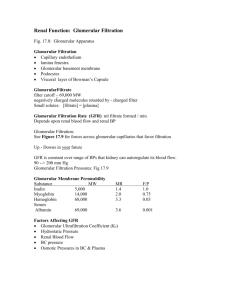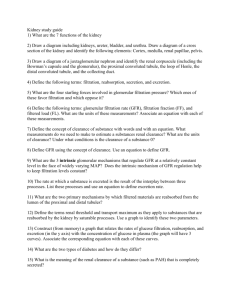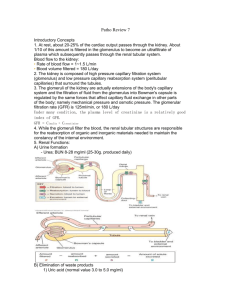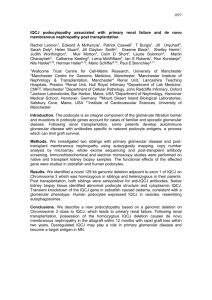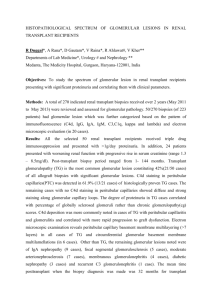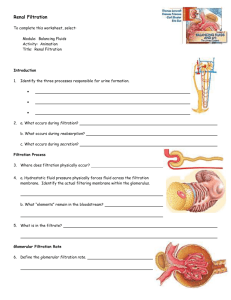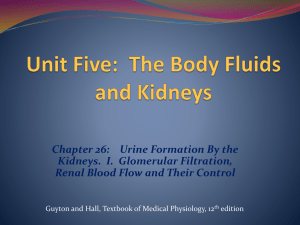Regulation of GFR
advertisement
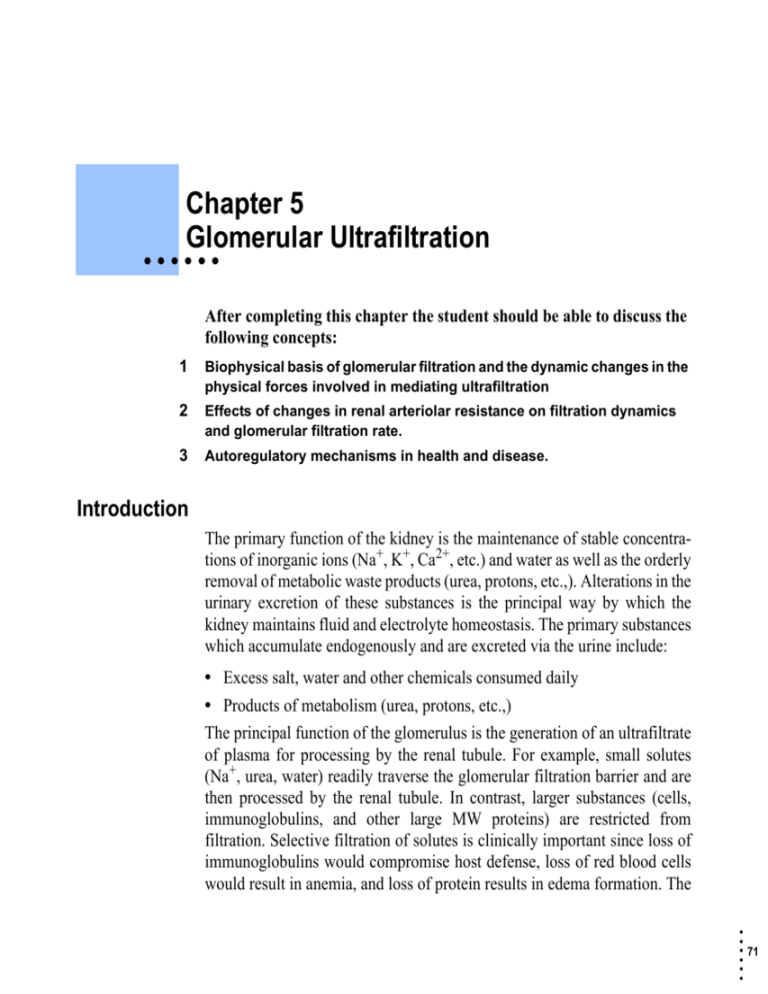
Chapter 5 Glomerular Ultrafiltration •••••• After completing this chapter the student should be able to discuss the following concepts: 1 Biophysical basis of glomerular filtration and the dynamic changes in the physical forces involved in mediating ultrafiltration 2 Effects of changes in renal arteriolar resistance on filtration dynamics and glomerular filtration rate. 3 Autoregulatory mechanisms in health and disease. Introduction The primary function of the kidney is the maintenance of stable concentrations of inorganic ions (Na+, K+, Ca2+, etc.) and water as well as the orderly removal of metabolic waste products (urea, protons, etc.,). Alterations in the urinary excretion of these substances is the principal way by which the kidney maintains fluid and electrolyte homeostasis. The primary substances which accumulate endogenously and are excreted via the urine include: • Excess salt, water and other chemicals consumed daily • Products of metabolism (urea, protons, etc.,) The principal function of the glomerulus is the generation of an ultrafiltrate of plasma for processing by the renal tubule. For example, small solutes (Na+, urea, water) readily traverse the glomerular filtration barrier and are then processed by the renal tubule. In contrast, larger substances (cells, immunoglobulins, and other large MW proteins) are restricted from filtration. Selective filtration of solutes is clinically important since loss of immunoglobulins would compromise host defense, loss of red blood cells would result in anemia, and loss of protein results in edema formation. The • • • 71 • • • ultrafiltrate generated by the glomerulus is subsequently processed by the renal tubule through complex reabsorptive and secretory mechanisms (Figure 5-1). For example, some substances (K+) undergo reabsorption and secretion prior to elimination in the urine. In contrast, other substances such as Na+ primarily undergo reabsorption while some substances (organic acids) principally undergo secretion. Nonetheless, the ultrafiltration of plasma constitutes an essential first step in the maintenance of fluid and electrolyte homeostasis. FIGURE 5-1. Overview of the steps involved in processing urine. omerular tuft Gl Secrete: Organic ions, drugs Secrete: K+ and H+ thin loop Glomerular Filtration Proximal Tubule Distal Tubule Passive water and NaCl movement Reabsorb: NaCl water amino acids sugars Reabsorb: NaCl water Glomerular Filtration Rate In normal resting man the glomerular filtration rate (GFR) averages 125 cc/min. The ultrafiltrate is derived from an average total renal plasma flow (RPF) of 600 cc/min. The ratio of glomerular ultrafiltrate to renal plasma flow is referred to as the filtration fraction (FF): GFR FF = -----------RPF EQ 5-1 where, RPF = RBF × ( 1 – Hct ) . The FF represents the fraction of plasma which is filtered across the glomerular capillary bed. Alterations in the FF can have an important effect on proximal tubular reabsorption of fluid (See page 96). The glomerular filtration rate is several fold that of fluid movement in capillary beds of other tissues, principally because the surface area available for diffusion plus the permeability of the glomerular capillary membrane (Kf) is approximately 100 fold that of other capillary beds. • • 72 •• • • Chapter 5 Physical Determinants of Glomerular Filtration The net filtration across a capillary bed (including the glomerular capillary membrane) is governed by the algebraic sum of hydrostatic and oncotic pressures across the capillary wall (Figure 5-2). FIGURE 5-2. Schematic depiction of the physical determinants responsible for the formation of an ultrafiltrate of plasma in Bowman’s space. The principal driving force for the formation of the glomerular ultrafiltrate is the hydraulic pressure within the glomerular capillary (P GC). In contrast, the principle forces opposing filtration include the oncotic pressure (¼ GC) within the glomerular capillary and hydrostatic pressure in Bowman’s space (P BS ). Net ultrafiltration is further modulated by the hydraulic permeability and surface area of the glomerular capillary (K f ). Distal glomerular capillary Proximal glomerular capillary ng π G easi Incr FLOW PGC ΠGC C PGC PBS ΠGC PBS BOWMAN'S SPACE The glomerular filtration rate can be derived using the following mathematical relationship: GFR = K f × ( P GC – P BS ) – ( π GC – π BS ) = K f × ( ΔP – Δπ ) EQ 5-2 = K f × P UF where; Kf is the membrane porosity × surface area; PGC is the hydrostatic pressure in the glomerular capillary network; PBS is the Bowman’s space pressure; πGC is the glomerular capillary oncotic pressure; πBS is the Bowman’s space oncotic pressure; ΔP is the transcapillary hydrostatic pressure (PGC – PBS); Δπ is the transcapillary oncotic pressure (πGC – πBS) and PUF is the net ultrafiltration pressure (see below). Glomerular Ultrafiltration • • • 73 • • • Since the glomerular ultrafiltrate is typically protein free, πBS is equal to zero, and, thus, the oncotic pressure in Bowman’s space is usually excluded from the above analysis. Therefore, the major direct determinants of GFR include: • PGC • PBS • Kf • πGC In addition to the above direct determinants of GFR, RPF also indirectly modulates GFR and will be discussed below. Glomerular Ultrafiltration Dynamics In general, increases in glomerular capillary hydrostatic pressure will increase GFR while decreases result in the opposite effect. It is important to note that there is little change in glomerular pressure from the beginning to the end of the glomerular capillary bed. Thus, the glomerular capillary is a low resistance bed. In contrast, the interconnected capillaries of the glomerulus are juxtaposed between two muscular (an afferent, Ra and an efferent, Re) arterioles. This unusual vascular arrangement allows for divergent control of RBF and GFR (Figure 5-4). Indeed, the function of this vascular arrangement is important for the physiological regulation of GFR and blood flow in various disease states. For example, physiological changes in the ratio of Ra to Re permit maintenance of total RBF and GFR when perfusion pressure to the kidney is reduced e.g. autoregulation (Figure 5-6). PGC. Kf. The glomerulus contains contractile cells within the glomerular mesangium which are believed to regulate glomerular surface area (and hence Kf) by contracting or relaxing the interconnected glomerular capillaries. In general, increases in Kf will tend to increase GFR while decreases will tend to decrease GFR. For example, contraction of glomerular mesangial cells will reduce glomerular volume and surface area which, in turn, will lower Kf and, accordingly, GFR. Although beyond the scope of • • 74 •• • • Chapter 5 this discussion, the magnitude of change in GFR in response to alterations in Kf is dependent on the whether filtration equilibrium vs disequilibrium exists (Figure 5-3). FIGURE 5-3. Schematic depiction of the changes in filtration dynamics along the length of the glomerular capillary. Because the resistance in the glomerular capillary network is small, there is little change in glomerular capillary hydrostatic pressure along the length of the capillary. In addition, the hydrostatic pressure in Bowman’s space is nearly constant because of unimpeded flow downstream. In contrast, arteriolar oncotic pressure rises sharply along the capillary bed incident to ultrafiltration of a protein free ultrafiltrate. Under some circumstances the rise in oncotic pressure may achieve filtration equilibrium (zero net ultrafiltration). The net ultrafiltration pressure is proportional to the shaded area under the curve. Filtration Equilibrium 50 Pressure, mmHg 40 30 PGC ΠGC 20 10 PBS 0 Distance along length of the glomerular capillary 1 Area under the curve, AUC ~mean ultrafiltration pressure, PUF Glomerular Ultrafiltration • • • 75 • • • FIGURE 5-4. Relationship between glomerular capillary pressure, renal blood flow, and arteriolar resistance. Because the glomerular capillary network is interposed between two resistance beds (afferent and efferent arteriole), a complex system of renal blood flow, glomerular pressure and GFR arises. For example, an increase in afferent arteriolar resistance (panel B) reduces RBF and intraglomerular pressure. These effects diminish glomerular filtrate formation. In contrast, constriction of the efferent arteriole (panel C) augments glomerular pressure but reduces RBF. The former effect would facilitate glomerular filtration while the latter inhibits ultrafiltration. Therefore, the net effect of efferent arteriolar vasoconstriction on GFR is unpredictable. A PGC Efferent arteriole Afferent arteriole B PGC RBF Afferent arteriolar resistance C PGC RBF Efferent arteriolar resistance • • 76 •• • • Chapter 5 Normally Bowman’s space pressure remains constant because of unimpeded flow of glomerular filtrate. An obstruction to urinary outflow distal to Bowman’s space will result in a fall in ΔP (and hence GFR) incident to a rise in Bowman’s space pressure. PBS. CLINICAL CORRELATION Patients with urinary tract obstruction secondary to cancer, stones, or prostatic enlargement may present with profound reductions in GFR. Renal function can often be restored following removal of the obstructing lesion. The glomerular capillary oncotic pressure is the principle factor opposing glomerular filtration. Because the plasma filtered at the glomerulus is protein free, the oncotic pressure rises (albeit, nonlinearly) throughout the glomerular capillary network. Thus, the magnitude of glomerular filtration (and, accordingly, the forces favoring filtration) slowly diminishes along the length of the glomerular capillary (Figure 5-3). Direct measurements of glomerular hemodynamics in the rat and dog have demonstrated that glomerular capillary oncotic pressure reaches glomerular transcapillary hydraulic pressure prior to the end of the glomerular capillary. This phenomenon is referred to as filtration equilibrium because filtration ceases at this point. In circumstances characterized by increases in renal plasma flow, filtration equilibrium is shifted distally along the capillary bed resulting in an increase in net ultrafiltration pressure and, thus, an increase in GFR. In this way RBF can modulate GFR by altering the oncotic pressure profile (Figure 5-5). ΠGC. Regulation of Renal Blood Flow The regulation of renal blood flow is mediated by changes in renal vascular resistance and is described by the following relationship: Renal Perfusion Pressure RBF = ---------------------------------------------------------------Renal Vascular Resistance EQ 5-3 where, the renal perfusion pressure is the difference between systemic pressure and renal venous pressure, and renal vascular resistance (RVR) is primarily a consequence of arteriolar tone in the afferent and efferent arterioles. Indeed, 85% of the total RVR is secondary to the vascular tone of the afferent and efferent arterioles. Glomerular Ultrafiltration • • • 77 • • • FIGURE 5-5. Effects of increasing RBF on net ultrafiltration pressure. Although, RBF is not considered in the mathematical derivation of glomerular ultrafiltration, it is nonetheless, an important determinant of GFR. For example, the normal oncotic pressure profile along the glomerular capillary is depicted by the thick line. Following an increase in RBF, filtration equilibrium is moved distally along the capillary to point B. Accordingly, the area under the curve increases (net ultrafiltration pressure increases) resulting in an augmented GFR. Filtration Equilibrium A 50 B 40 30 20 Normal PUF (Area under curve, AUC) 10 PUF after an increase in RBF 0 Distance along the length of glomerular capillary 1 Although Eq 5-3 predicts a linear increase in RBF in response to an increase in perfusion pressure, the RBF (and GFR) remain remarkably constant over a wide range of systemic arterial pressures (Figure 5-6). This phenomenon is referred to as autoregulation. The physiological significance of autoregulation is sustainment of RBF, GFR, and solute excretion during normal day to day variations in posture and exercise which tend to alter systemic pressure and renal perfusion. Notwithstanding, it is essential to appreciate that autoregulation has limits which can be exceeded under specific circumstances such as following severe volume contraction e.g., hemorrhage or dehydration (Figure 5-9). There are 3 major mechanisms which have been postulated to contribute to the phenomenon of autoregulation: • Myogenic Stretch • Tubuloglomerular Feedback • Angiotensin II • • 78 •• • • Chapter 5 FIGURE 5-6. Autoregulation of renal blood flow and glomerular filtration rate Renal Plasma Flow/Glomerular Filtration Rate over a wide range of perfusion pressures (0-240 mm Hg). RBF and GFR are held constant over the range of 80-200 mm Hg. Pressures exceeding these limits will alter RBF and GFR as predicted in the illustration below. In addition, the normal autoregulatory relationship can be altered (depicted relationship may be shifted to the right or left) after long-term exposure to some underlying conditions e.g., hypertension. Autoregulatory Range 40 80 120 160 200 240 280 Renal Perfusion Pressure (mm Hg) Myogenic Stretch Reflex (Bayliss Mechanism) The myogenic mechanism is similar to that noted in other autoregulating vascular beds. In response to a decrease in perfusion pressure the afferent arteriole vasodilates and, therefore, lowers RVR and attenuates the expected fall in RBF incident to a reduction in perfusion pressure. The opposite sequence of events occurs following an elevation in renal perfusion pressure. The mechanism may involve variable entry of Ca2+ into cells. Tubuloglomerular Feedback Tubuloglomerular feedback (TGF) is an intrinsic feedback loop designed to protect against large fluctuations in GFR and solute excretion (Figure 5-7). For example, an increase in renal perfusion pressure would tend to augment glomerular capillary hydraulic pressure and RBF. This, in turn, elevates the Glomerular Ultrafiltration • • • 79 • • • GFR. An increase in GFR would augment urine delivery to the distal nephron and eventuate in increased urine excretion. Unabated, this could result in significant (even life-threatening) solute and water losses in the urine. However, the macula densa cells of the distal nephron sense changes in delivery of NaCl and/or water by an as yet undefined mechanism, resulting in the release of a potent renal afferent arteriolar vasoconstrictor (possibly adenosine or angiotensin II). This “brake” mechanism appropriately inhibits the increment in RBF and PGC by constricting the afferent arteriole, decreasing RBF and returning GFR to normal. The latter prevents the excretion of large quantities of solute and water in the urine. CLINICAL CORRELATION TGF may be an important mechanism in the prevention of massive losses of fluid in the setting of injury to the renal tubular reabsorptive epithelium (also known as acute tubular necrosis, ATN). For example, certain drugs are capable of injuring the proximal tubular reabsorptive epithelium which could precipitate massive fluid losses. However, activation of TGF would lead to decrements in the GFR and RBF of the parent glomerulus preventing life-threatening fluid losses from occurring. Interestingly, disorders which result in proximal tubule epithelial injury are invariably associated with profound (? protective) reductions in GFR. FIGURE 5-7. Schematic depiction of tubuloglomerular feedback. RENAL ARTERIAL PRESSURE PGC RBF GFR NaCl CONCENTRATION IN THE MACULA DENSA RELEASE OF VASOACTIVE COMPOUND(s) FROM ?? CELLS RA • • 80 •• • • Chapter 5 Inhibits FLUID DELIVERY TO THE MACULA DENSA Although TGF may play a role in certain clinical disorders (acute tubular necrosis), its general role in the maintenance of normal renal function remains poorly understood. Moreover, several unknowns such as the variable that is sensed at the macula densa Na versus Cl , etc.) and the effector which elicits altered arteriolar tone (adenosine, etc.) have remained elusive. In general, TGF is thought to protect against fluctuations in GFR and RBF in the face of day to day variations in renal perfusion pressure such as changes in posture and exercise. + – Renin-Angiotensin System The renin-angiotensin system (RAS) is activated by stretch receptors (‘”baroreceptors”) in the afferent arteriole of the juxtaglomerular apparatus resulting in the release of the enzyme renin. Renin ultimately leads to the synthesis of angiotensin II. Angiotensin II is a potent renal vasoconstrictor which preferentially constricts the efferent arteriole. A rise in efferent arteriolar tone raises glomerular capillary pressure which, in turn, increases the GFR. The latter effect tends to offset the reduction in RBF incident to the rise in RVR induced by efferent arteriolar vasoconstriction. Renin release by the kidney can also be modulated by the sympathetic nervous system since the afferent arteriole is innervated by β-adrenergic fibers. Electrical stimulation of the renal nerves or an increase in circulating catecholamines elicit an increase in renin release from the granular cells of the afferent arteriole. The precise role of the macula densa in modulating the release of renin from the granular cells of the afferent arteriole remains incompletely understood, however, changes in the composition of tubular fluid bathing the macula densa as well as flow rate modulates the release of renin. Although the direction of change in renin release can be divergent depending on the experimental conditions, in general an increase in delivered NaCl decreases renin release while a decrease exerts the opposite effect. The cellular events which elicit this response are poorly understood. CLINICAL CORRELATION Volume contraction evokes avid NaCl and water retention by the kidney. The anticipated decrease in distal delivery of NaCl would evoke an increase in circulating renin and angiotensin II. The latter promotes NaCl retention which, in turn, may contribute to restoration of the arterial blood volume and pressure Glomerular Ultrafiltration • • • 81 • • • FIGURE 5-8. Summary of renal adaptation to a reduction in perfusion pressure. At least 3 factors contribute to maintenance of RBF and GFR when perfusion pressure is reduced 1) myogenic reflex 2) tubuloglomerular feedback and 3) angiotensin II. RA MAINTENANCE OF RBF MYOGENIC REFLEX AND TUBULOGLOMERULAR FEEDBACK MAINTENANCE OF GFR REDUCED RENAL PERFUSION PRESSURE ANGIOTENSIN II RE MAINTENANCE OF PGC Role of the Macula Densa in Regulating Renal Hemodynamics The relationship between the macula densa as a sensor is best understood in terms of its relevance to minute to minute variations in renal perfusion pressure. For instance, an acute decrease in glomerular perfusion pressure reduces GFR and, thus, delivery of solute and water to the macula densa. Activation of the macula densa in this manner promotes afferent arteriolar vasodilatation and restores GFR and solute excretion toward normal e.g., tubuloglomerular feedback (TGF). In this context TGF should be viewed as an intrarenal phenomenon designed to sustain the delivery of solute constant during acute variations in renal perfusion pressure. The effector responsible for changes in afferent arteriolar resistance under such conditions remains poorly understood, but may involve changes in the local concentration of renin, adenosine, prostaglandins, or nitric oxide. One must contrast (indeed reconcile) this reflex with the changes in solute excretion induced by a reduction in total blood volume (e.g., volume contraction and a decreased cardiac output). The latter scenario decreases effective arterial volume, • • 82 •• • • Chapter 5 GFR, and solute excretion, however, this phenomenon persists until the total blood volume is restored (i.e., TGF is appropriately overridden under such circumstances) A reduction in effective arterial blood volume elicits a complex neurohumoral response which is designed to promote solute and water reabsorption and, accordingly, restore cardiac output toward normal. The retention of solute and water is, in part, mediated by an increase in circulating renin derived from the granular cells of the kidney (via a decrease in perfusion pressure). Importantly, the attendant rise in angiotensin II directly promotes renal NaCl and water retention, thus, restoring intravascular volume toward normal. FIGURE 5-9. Mechanism of deranged GFR in the presence of a normal systemic blood pressure. A reduction in effective arterial blood volume (dehydration/hemorrhage) elicits complex neurohumoral signals which may attenuate normal autoregulation. For example, volume contraction activates carotid baroreceptors which increase sympathetic tone. The SNS is a potent renal vasoconstrictor which evokes a fall in RBF in spite of renal autoregulation. Counterregulatory mechanisms (prostaglandins) which modulate this response are shown to highlight the interrelationship of multiple systems involved in regulating RBF and GFR. Stimulate release of vasodilatory prostaglandins Increased SNS Ra Restore RBF Re Restore PGC Myogenic Reflex TG feedback Activation of atrial and carotid baroreceptors Volume Contraction Decrease PGC and RBF Attenuation Increased catecholamines Reduced Renal Perfusion Pressure Counter-regulatory pathway Pathophysiological effects - Override normal autoregulation Angiotensin II Normal autoregulatory mechanisms Glomerular Ultrafiltration • • • 83 • • • Shift from Renal Compensation to Decompensation It is important to appreciate that despite autoregulation, RBF and GFR can substantially vary from normal when certain conditions exceed the limits of normal autoregulation (Figure 5-9). For example, the afferent and efferent arterioles are richly innervated with α1-adrenergic receptors. These receptors are activated in response to changes in sympathetic neural tone and to circulating catecholamines. Both of these effectors potently vasoconstrict the renal vasculature. Such intense vasoconstriction of the kidney frequently overrides the normal autoregulatory pathways, thus, eliciting a reduction in RBF and GFR. Therefore, under some circumstances, activation of certain potent vasoactive systems can exceed the normal autoregulatory mechanisms and abrogate the expected maintenance of RBF and GFR. Severe volume contraction from hemorrhage is one example that can elicit such a response. Mediators of Altered Vascular Resistance (Figure 5-1) summarizes the effects of physiologically important vasoactive compounds on intrarenal hemodynamics. Some of these substances may participate in pathophysiological conditions which are characterized by alterations in RPF and GFR. For example, recent studies suggest that endothelin may contribute to the marked reduction in RPF and GFR observed following acute renal injury. TABLE 5-1. Intrarenal effects of various vasoactive compounds. • • 84 •• • • Chapter 5 Mediator Source RA RE RBF PGC Endothelin Endothelial Cells ↑↑ ↑↑ ↓↓ ↑ PGE2, PGI2 Membrane Lipids ↓ ↓ ↑ ↔ TXA2 Membrane Lipids ↑ ↑↑ ↓ ↑ Nitric Oxide Endothelial Cells ↓↓ ↓↓ ↑↑ ↔ Angiotensin II Angiotensinogen ↑ ↑↑ ↓ ↑↑
